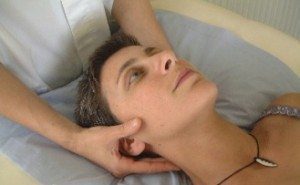This approach is currently taught by various osteopathic teaching establishments in the UK, USA, Canada and Europe. Cranial Osteopathy forms part of standard osteopathic undergraduate UK training.
Cranial Osteopathy
A recent survey of cranial osteopaths found that some directly seek this kind of treatment. Two-thirds of patients in the survey came with problems relating to musculoskeletal pain or stiffness, 13% came with babies.
When compared to the general osteopathic population, numbers of treatments and adverse reaction rates were similar.
 Adverse treatment reactions reported after cranial osteopathy were reported as appearing to be temporary and typically involved an exacerbation of symptoms such as pain or stiffness and fatigue.
Adverse treatment reactions reported after cranial osteopathy were reported as appearing to be temporary and typically involved an exacerbation of symptoms such as pain or stiffness and fatigue.
Many patients reported a significant reduction in symptom severity following an average of three treatments with cranial osteopathy
(March 2015, Vol 18, Issue 1, Pages 13–21 Day-to-day practice of osteopaths using osteopathy in the cranial field, who are affiliated with the Sutherland Cranial College of Osteopathy (SCCO): A national survey by means of a standardised data collection tool J. Wilkinson, K.J. Thomas, J.V. Freeman, B. McKenna)
At the start of your first session, we will take time to listen to you and ask questions about your symptoms, diet, general health, activities and lifestyle. This helps us to suggest appropriate treatment(s) that you can consider.
Whatever treatment is given, osteopaths carry out an examination of the area(s) of your body causing discomfort. This may include tests such as taking blood pressure or testing reflexes. Sometimes the cause of the problem may be in a different area to the pain, so the whole body is usually examined.
 We will feel for changes in your muscles and joints and other tissues and examine these areas to identify problems. We assess posture and the way you move.
We will feel for changes in your muscles and joints and other tissues and examine these areas to identify problems. We assess posture and the way you move.
Osteopaths use a wide range of gentle hands on techniques. Treatment varies between patients depending on age, fitness and diagnosis. Before you receive treatment your osteopath and you will jointly decide an appropriate and suitable treatment plan.
If you have any concerns about your treatment we are happy to discuss these with you at any point.
